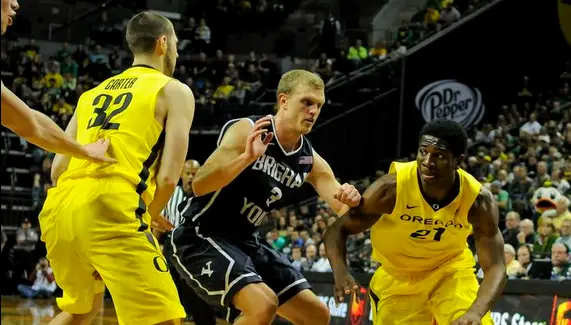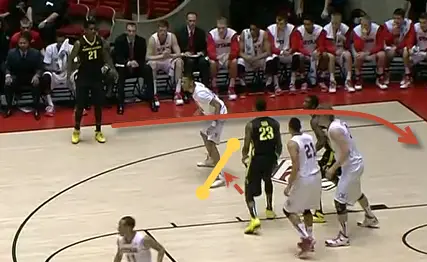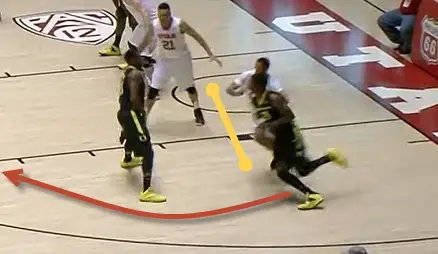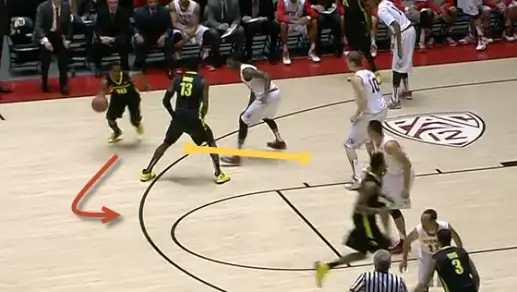(FishDuck Note: Analysis is the theme of this site, thus we introduce Oregon Basketball Analysis by Lawrence Hastings. We will be alternating football and basketball analysis every other week through the rest of the Duck Men’s Basketball season. This week’s article does not have GIFs, but we will have them for you next time. Charles)
The Oregon men’s basketball team currently boasts one the most potent offenses in the nation, averaging almost 90 points a game. And, although it seems as though we’re often in transition, the Ducks actually have a half-court offense. It’s difficult to explain the Ducks in the half court, but there is a certain aspect of it that cannot go unmentioned — the screens.
In basketball, the screen can be a godsend for offenses. Sometimes an opponent’s defense can be tight, aggressive and suffocating to the point of exhaustion, and, in these instances, offenses should and will start screening.
For the uninitiated, a ‘screen’ is where an offensive player blocks a defensive player off from guarding another offensive player, if it is a man-up D. It is essentially a way for someone to get open and escape a tenacious defense. We often associate screens, or picks, with on-ball play such, as the ‘pick-and-roll,’ but it can actually be performed all over the court.
Back Screen
Back screens occur when the offensive player, or screener, blocks the defender’s path from behind. Also, note that this is typically performed off-ball, as shown above, where forward Elgin Cook is approaching Damyean Dotson’s defender from behind.
He will square his shoulders to the defender, cross his arms over his chest for protection, and then remains still, as Dotson jolts past his right shoulder. It’s important that Cook remain still as to avoid an offensive foul or illegal screen call. It is also important that Dotson run off the screen crisply and closely. This way, there is no space or time for the defender to recover. Dotson will then run baseline to the other side of the floor and, theoretically, be open for a corner three.
Down Screen
Down screens, the usual first move in a motion offense such as Oregon’s, is again here performed by Damyean Dotson and Elgin Cook. This type of screen is used to free up a perimeter player that is currently in or around the post. It begins with Dotson remaining still on the block, yet ready to pounce. Elgin Cook will approach Dotson’s defender, and, facing his own basket, block the defender’s path upwards toward the three-point line. Dotson will then explode off the screen toward the perimeter. This may free him up for a jumper, but usually allows just enough time to simply catch the ball and make a play in isolation.
Away Screen
Away screens should happen early in any half-court set. They are usually used when a player cannot get open himself, so instead of standing around in awe, they screen away from the ball, to get a teammate open. In this case however, Elgin Cook is simply opening up the floor by leaving the area where an on-ball screen is already happening.
Cook moves away from the ball (highlighted in yellow) and toward teammate Jason Calliste. Calliste will attempt to set his defender up, by taking one or two steps to the right, then exploding back to the left, around Cook, who is ready to catch the rock at the top of the perimeter. This form of screen isn’t as much about finding a scoring option right away, as it is about merely spacing the floor and getting guys open. In fact, it is actually Cook who scores on this play, after setting the pick.
Ball Screen
Ahh, the on-ball screen. Anyone who watches basketball is at least somewhat aware of the on-ball screen. Every type of screen discussed here is important, but it is this type that gets all the credit.
Which makes sense, because basketball fans watch the ball and constantly look for flashy passes or crafty buckets — enter the ball screen.
Ball screens happen when an offensive player sets a pick for his teammate, who has the ball. A team might utilize this tactic for any number reasons. They may want to free up the dribbler, initiate a two-man game, or even let the defender know that he needs to relax.
Here we see Richard Amardi setting the high screen for Johnathan Loyd. Keeping his dribble, Loyd will bolt past Amardi and prepare to make any number of plays from the top of the arc. Most often, though, we will see the Ducks attempt the notorious ‘pick-and-roll’ or ‘pick-and-pop.’
The Ducks will score points. They’d like to get out running and get transition baskets, but that’s not always possible. Ergo, these screens will set them free.
Basketball is, simply, a complicated sport.
Lawrence Hastings
EugeneDailyNews/FishDuck.com Basketball Analyst
Eugene, Oregon
Main Photo by Craig Strobeck
Related Articles:
Lawrence Hastings spent the first fifteen years of his life in Los Angeles, California before moving to Eugene, Oregon. Transitioning to Duck land was easy for him seeing as he was raised a Pacific Conference fan since birth. So Lawrence, loving his new green home, chose to pursue a Sports Business degree at the University of Oregon. In his spare time Lawrence plays and watches sports religiously, with a particular passion for basketball. His favorite Duck of all time is Aaron Brooks, whom he met at local basketball camp as a teenager.





